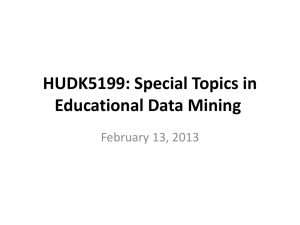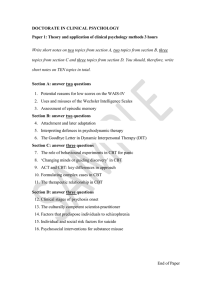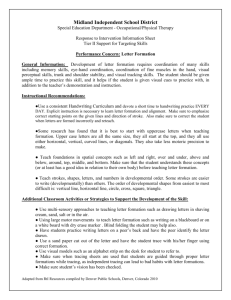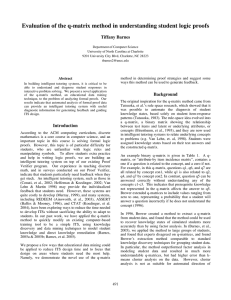Extracting Student Models for Intelligent Tutoring Systems John C. Stamper
advertisement
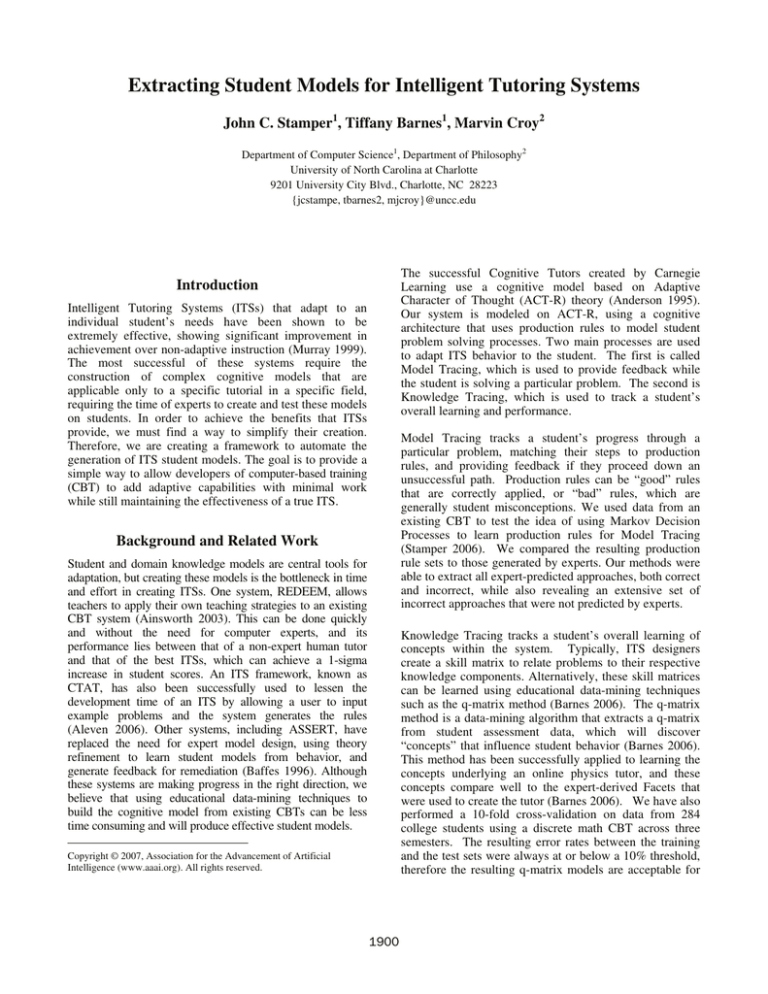
Extracting Student Models for Intelligent Tutoring Systems
John C. Stamper1, Tiffany Barnes1, Marvin Croy2
Department of Computer Science1, Department of Philosophy2
University of North Carolina at Charlotte
9201 University City Blvd., Charlotte, NC 28223
{jcstampe, tbarnes2, mjcroy}@uncc.edu
The successful Cognitive Tutors created by Carnegie
Learning use a cognitive model based on Adaptive
Character of Thought (ACT-R) theory (Anderson 1995).
Our system is modeled on ACT-R, using a cognitive
architecture that uses production rules to model student
problem solving processes. Two main processes are used
to adapt ITS behavior to the student. The first is called
Model Tracing, which is used to provide feedback while
the student is solving a particular problem. The second is
Knowledge Tracing, which is used to track a student’s
overall learning and performance.
Introduction
Intelligent Tutoring Systems (ITSs) that adapt to an
individual student’s needs have been shown to be
extremely effective, showing significant improvement in
achievement over non-adaptive instruction (Murray 1999).
The most successful of these systems require the
construction of complex cognitive models that are
applicable only to a specific tutorial in a specific field,
requiring the time of experts to create and test these models
on students. In order to achieve the benefits that ITSs
provide, we must find a way to simplify their creation.
Therefore, we are creating a framework to automate the
generation of ITS student models. The goal is to provide a
simple way to allow developers of computer-based training
(CBT) to add adaptive capabilities with minimal work
while still maintaining the effectiveness of a true ITS.
Model Tracing tracks a student’s progress through a
particular problem, matching their steps to production
rules, and providing feedback if they proceed down an
unsuccessful path. Production rules can be “good” rules
that are correctly applied, or “bad” rules, which are
generally student misconceptions. We used data from an
existing CBT to test the idea of using Markov Decision
Processes to learn production rules for Model Tracing
(Stamper 2006). We compared the resulting production
rule sets to those generated by experts. Our methods were
able to extract all expert-predicted approaches, both correct
and incorrect, while also revealing an extensive set of
incorrect approaches that were not predicted by experts.
Background and Related Work
Student and domain knowledge models are central tools for
adaptation, but creating these models is the bottleneck in time
and effort in creating ITSs. One system, REDEEM, allows
teachers to apply their own teaching strategies to an existing
CBT system (Ainsworth 2003). This can be done quickly
and without the need for computer experts, and its
performance lies between that of a non-expert human tutor
and that of the best ITSs, which can achieve a 1-sigma
increase in student scores. An ITS framework, known as
CTAT, has also been successfully used to lessen the
development time of an ITS by allowing a user to input
example problems and the system generates the rules
(Aleven 2006). Other systems, including ASSERT, have
replaced the need for expert model design, using theory
refinement to learn student models from behavior, and
generate feedback for remediation (Baffes 1996). Although
these systems are making progress in the right direction, we
believe that using educational data-mining techniques to
build the cognitive model from existing CBTs can be less
time consuming and will produce effective student models.
Knowledge Tracing tracks a student’s overall learning of
concepts within the system. Typically, ITS designers
create a skill matrix to relate problems to their respective
knowledge components. Alternatively, these skill matrices
can be learned using educational data-mining techniques
such as the q-matrix method (Barnes 2006). The q-matrix
method is a data-mining algorithm that extracts a q-matrix
from student assessment data, which will discover
“concepts” that influence student behavior (Barnes 2006).
This method has been successfully applied to learning the
concepts underlying an online physics tutor, and these
concepts compare well to the expert-derived Facets that
were used to create the tutor (Barnes 2006). We have also
performed a 10-fold cross-validation on data from 284
college students using a discrete math CBT across three
semesters. The resulting error rates between the training
and the test sets were always at or below a 10% threshold,
therefore the resulting q-matrix models are acceptable for
Copyright © 2007, Association for the Advancement of Artificial
Intelligence (www.aaai.org). All rights reserved.
1900
predicting student concept states. Based on this evidence,
we believe that the q-matrix method can be used to
automatically update the Knowledge Tracing model.
combined model for integration into a specific CBT
system. We can derive production rules for logic proofs
using MDPs, and believe we will be able to generate
appropriate feedback based on these rules. We can derive
a concept model using the q-matrix method, and use this
model to assess and predict student knowledge. These
basic components provide the foundations for building
Knowledge and Model Tracing into a CBT and may
provide the full adaptive capability of a traditional ITS.
System Design
Our system will be comprised of a Knowledge Tracing
Module (KTM) that will assess and direct student progress,
and a Model Tracing Module (MTM) to provide problemspecific feedback. These modules will be added to an
existing graphical CBT called Deep Thought (DT). This
system allows students to work forward or backwards in
solving propositional logic proofs. Over 200 students use
this program each semester as part of a philosophy course.
Initially, our system will focus on building a stable set of
rules and concepts. We plan to validate the predictions the
system generates about student progress. We will also
create a feedback generation system and an interface to
allow educators to edit this feedback. Later, we will
compare performance using our new system to that using
DT alone to determine if improvements are made.
The KTM, as described above, will make decisions based
on a student state relative to the overall skill matrix for the
problems being solved. The skill matrix will be initially
derived from historical DT data, and will be continually
updated as new students use the system. The MTM will
match student performance to a production rule system,
initially derived using the MDP methods from our previous
work, and will also be continually updated to include new
rules to describe student behavior.
References
Ainsworth, S., Major, N., Grimshaw, S., Hayes, M.,
Underwood, J., Williams, B. & Wood, D. 2003. REDEEM:
Simple Intelligent Tutoring Systems From Usable Tools, in
T. Murray, S. Blessing & S. Ainsworth (eds). Advanced
Tools for Advanced Technology Learning Environments.
pp. 205-232. Amsterdam: Kluwer.
The probabilities associated with a particular path through
the production rule system are updated by every step that a
student makes. The system then predicts a student’s next
action based on both the current rules associated with the
problem being worked on and the student’s current
classification, which is derived from the KTM. When
probabilities are reliable for a student solution path,
feedback will be given whenever the student appears to be
heading off of a successful path while attempting to solve a
problem. If the student starts down a path that has not
been seen before, there may be no rules associated with the
path. In that case, the student will be allowed to traverse
that path and new rules will be generated.
Aleven, V., McLaren, B. M., Sewall, J., & Koedinger, K.
(2006). The Cognitive Tutor Authoring Tools (CTAT):
Preliminary evaluation of efficiency gains. In M. Ikeda, K.
D. Ashley, & T. W. Chan (Eds.), Proc. Intelligent Tutoring
Systems Conference, (pp. 61-70). Berlin: Springer Verlag.
Anderson, J. R., Corbett, A. T., Koedinger, K. R., &
Pelletier, R. 1995. Cognitive Tutors: Lessons Learned.
Journal of the Learning Sciences, 4(2), 167-207.
Baffes, P. & R.J. Mooney. 1996. A Novel Application of
Theory Refinement to Student Modeling. Proc. 13th
National Conference on Artificial Intelligence (AAAI-96),
pp. 403-408, Portland, OR.
Student knowledge is tracked via the probability that a
particular student understands a particular group of
concepts. Generating conceptual information is
accomplished through the q-matrix educational datamining algorithm applied to the student data already
accumulated. The KTM continually updates the q-matrix in
the background as more student data is gathered. This
conceptual information is used to classify students into
knowledge states, which will be used in turn by the MTM.
Based on the student’s success or failure on each action,
the student’s knowledge state is updated to reflect the
probability that he/she understands each concept.
Barnes, T., Stamper, J., Madhyastha, T. 2006. Comparative
Analysis of Concept Derivation Using the Q-matrix
Method and Facets. In Educational Data Mining: Papers
from the 2006 AAAI Workshop, ed. Joseph E. Beck, 21-30.
Technical Report WS-06-05. AAAI, Menlo Park, CA.
Murray, Tom. 1999. Authoring intelligent tutoring
systems: An analysis of the state of the art. Intl. Journal of
Artificial Intelligence in Education, 10: 98-129.
Stamper, J. 2006. Automating the Generation of
Production Rules for Intelligent Tutoring Systems. Proc.
9th Intl. Conf. on Interactive Computer Aided Learning
(ICL2006), pp. 206-212,Villach, Austria.
Conclusions and Future Work
We have demonstrated that we can automatically generate
the individual parts of our model, and have designed the
1901
